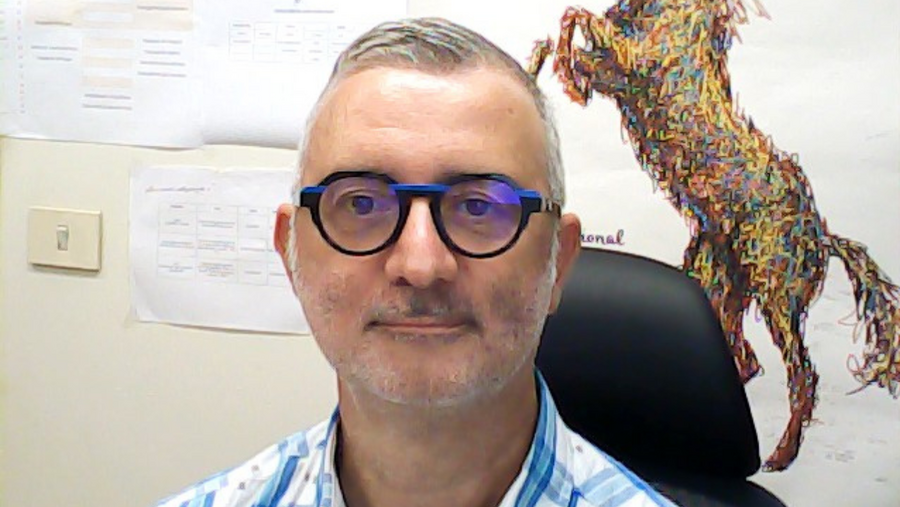Adolfo Paz: «The future of animal health lies in the rational use of antiparasitics and the promotion of prevention»

The systematic use of antiparasitic drugs in livestock farming over recent decades, among other things, has paved the way for the emergence and consolidation of what are now two of the most pressing challenges we face: antiparasitic resistance.
Therefore, exploring new avenues that promote the rational use of these drugs is critical to creating effective biological control strategies. This is something that Adolfo Paz Silva has been putting into practice for years.
A lecturer and researcher in the Department of Animal Pathology at Campus Terra and coordinator of the COPAR Research Group (Control of Parasites in Animals and People: Diagnosis, Prevention, and Treatment), today we turn to his expert voice to learn firsthand about the current state and future challenges of such important subjects as parasitology, zoonosis diagnosis, and animal health.
-The COPAR group, which you coordinate, has carried out extensive research aimed at the reliable diagnosis of parasitic diseases using immunodiagnostic techniques. What would you say have been the main advances in this field, and what challenges remain to be resolved?
-We started working on this in 2002. The aim was to try to fill the gap between the moment when animals or humans become infected with a liver parasite, Fasciola hepatica, and when they begin to show signs of infection.
This time lag is very important, as it allows the development of lesions or alterations to be prevented. As there were no techniques available at the time, our team decided to apply immunodiagnostic techniques.
The main achievements were related to trematodes in diseases affecting the liver of cows, such as fasciolosis and microgliosis. In fact, we had some approaches from private companies in central Europe that wanted to develop a commercial kit.
We remain in this field with the immunodiagnosis of diseases in horses. These diseases also affect the liver and can even cause hepatic encephalitis due to the accumulation of toxic substances, which can affect the animal's behavior. In this regard, we receive between 30 and 40 samples each year from clinical veterinarians throughout Spain.
-Much of your research has focused on parasitic diseases that affect both animals and humans. To what extent is interdisciplinarity between veterinary medicine and public Health essential in zoonosis research today?
-There is a lot of talk now about the concept of One Health, in which the Health of people, animals, and the environment coexist closely. And, really, it is the only way we can move forward.
Starting with the fact that humans can also transmit diseases to animals. The term zoonosis has a rather anthropocentric connotation. Therefore, the interrelation between fields of knowledge is essential for our research to be truly effective.
A very fruitful example that is yielding excellent results is our collaboration with the Epidemiology Service of the Regional Ministry of Health (Xunta de Galicia) in the Galician Vector Surveillance Network because it is providing us with very interesting and useful information on the species of ticks present in Galicia, which helps them to be prepared and take the necessary measures, and also to reassure the population.
Six years ago, we discovered the presence of a tick (Hyalomma marginatum) that transmits Crimean-Congo fever. We brought it to the attention of the Epidemiology Service of the Regional Ministry of Health, and shortly afterward, they publicized it and took measures to ensure that doctors were aware of the issue and knew, for example, the symptoms that a person with this disease would present, what to do, etc.
-You mentioned greater awareness in order to achieve the goals proposed by the ‘One Health’ concept. We need to work hard in this area and create this interdisciplinary approach because, ultimately, it will improve public Health, animal health and the well-being of everyone. Is that right?
-Indeed. Furthermore, as public officials, we are truly accountable to the population (or at least we should be). And right now, we are seeing a boom in citizen collaboration, which is very positive. But we also need to know how to measure and find the right balance: we need to reduce the levels of alarmism.
-Changing the subject a little, the development of sustainable control methods based on saprophytic filamentous fungi is an innovative alternative to conventional treatments. What advantages does this approach offer over traditional pesticides?
-In the environment, as long as humans, who modify everything, do not intervene, everything tends to coexist in balance: pathogens and pathogen antagonists are in equilibrium. Horses or cows in the mountains do not usually have serious health problems (rather, they suffer from hunger) thanks to what is known as adaptation.
When this mechanism is disrupted, diseases appear. What we propose is the application of these fungi, which are normally found in the soil or appear on rotting fruit, to reduce the presence of parasites as they attack them. They do this to ensure their nutrition: it is a mechanism that favors their survival.
There are many parasites found in the soil, specifically in the form of eggs or larvae, for example. These saprophytic fungi eat them, reducing the risk of infection and allowing for less frequent deworming because it is not necessary.
On the other hand, food quality is totally assured. There is no need to wait for the withdrawal period to elapse. Another advantage of using these fungi is that they do not persist in the environment, as they serve as food for other organisms (mites, nematodes, earthworms, etc.). In short, it is a preventive methodology: it prevents parasites from developing in the soil and also avoids the risk of infection in animals and, therefore, in humans, i.e., it improves the environment and acts in favor of animals and people (One Health).

-Several of the COPAR group's lines of research have led to patents and collaborations with national and international companies. How do you assess the transfer of knowledge from the university to the productive sector?
-Much of the experience we have gained both nationally and internationally is due precisely to the excellent work of the people in the Valorization and Entrepreneurship Area at the University of Santiago de Compostela.
They are very enthusiastic about their work, demonstrating a strong dedication. They are extremely valuable staff members and also very generous with their time. I would like to see this area strengthened, with more resources to enhance its capabilities, allowing it to continue the excellent work it has been doing for many years.
-One of the most recent fields of your research is the use of animals as sentinels to monitor the risk of infection in humans. Which species are best suited for this surveillance work, and what are the key parameters you analyze?
-This is a very interesting topic, to be honest. Although, when you put it like that, it sounds like you are taking advantage of animals. But that is not the case at all.
There are a number of diseases that are transmitted through what are called vectors, such as ticks or Diptera. On the other hand, some animals may be exposed to certain viruses or bacteria but do not develop the disease. However, if these vectors bite people, the disease develops.
We mainly use horses and cows in rural areas or the mountains precisely because certain species of vectors prefer to be far away from people.
What do we do with them? We collect blood samples and analyze them. This way, in addition to confirming that the animal is healthy, we look for the presence of antibodies that can tell us whether or not the animal was exposed. Once we have all this information, we pass it on to the regional government, indicating the presence of a certain vector in a certain area to alert the relevant authorities.
So, going back to what I was saying at the beginning, a very nice relationship is established with the sentinels: they don't suffer at all, and we can request very valuable information. This is very useful both for looking after the Health of these animals and our own.
-Currently, the control of parasitic infections also faces a new challenge: the growing pressure to limit or ban the use of chemical antiparasitics in organic production. What role can your lines of research play in this new scenario?
-This is closely related to what I was saying before about sustainability and biological control. It is going to be the future because it is going to be mandatory, as is happening with antibiotics.
I would like to point out that there is a misconception about biological control, which is that at no point is the aim to eliminate the treatment of the animal. All these guidelines will reduce the risk and reduce the presence of pathogens in the soil, but they will not destroy them.
We use animals as vehicles for the fungi. We produce cookies or jellies that the animals consume. The fungal spores, which cannot reproduce within the organism due to the absence of necessary conditions, are then excreted in the feces.
So, if that animal is parasitized, it will not be cured, no matter how many fungi you give it. Treatment is always necessary, but the key is to reduce the frequency of treatments.
To this end, we are developing integrated protocols that, in addition to curing the infection, prevent a new disease or delay its occurrence as long as possible by incorporating fungi. This line of research has led us to sign an agreement with a group of companies in Colombia, Peru, and the Czech Republic, where the application of these fungi is being studied.
In conclusion, I believe that this is the future: rational use of antiparasitics without eliminating them but applying them after analyses show that they are necessary.
-Finally, looking to the future, what are the main strategic lines that your research group intends to develop in the coming years in the field of zoonotic parasitic diseases and biological control?
-In relation to this line of fungi, we believe that we are well advised and that it will soon come to fruition: we don't have to keep pushing it because it is already moving forward on its own.
Currently, we are focusing on our group, having recently added new members who need to assume responsibilities. Within the group, we are promoting the study of two vectors. We are very happy with RegaViVec (Galician Regional Government) in relation to mosquitoes. Funding from the Provincial Council of Lugo (Rural Area, Vice-Presidency) helped us to identify a species of Aedes japonicus for the first time in Galicia.
We need to strengthen this network and ensure that new members understand the importance of their work. Thanks to the agreement we have with Sergas, which I mentioned earlier, every day, we receive mosquitoes collected at health centers by family doctors. This, once again, reflects the One Health concept.
Another line of research we are promoting is the monitoring of the Health of sentinels. Since we take blood samples, we take the opportunity to check their parameters and identify diseases, whether zoonotic or not. In addition, since the owners of these animals collaborate with us, we also return the favor by letting them know, for example, if their livestock has low red blood cell counts or if it has parasites, and we suggest a course of action.
Finally, we are also working in the area of welfare. The immune system largely determines whether an infection progresses or not. Therefore, if the animal is happy because its living conditions are better, it will respond better to disease. And ultimately, if they don't get sick, neither will we.
